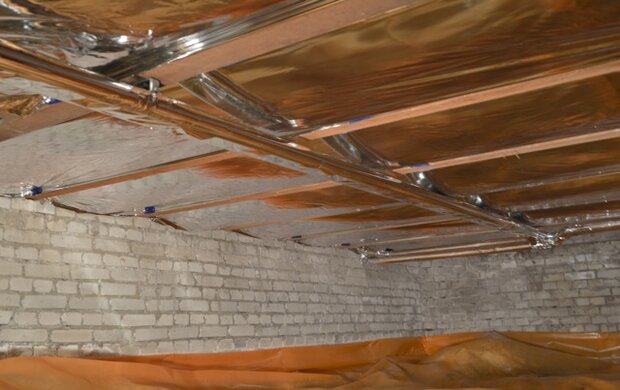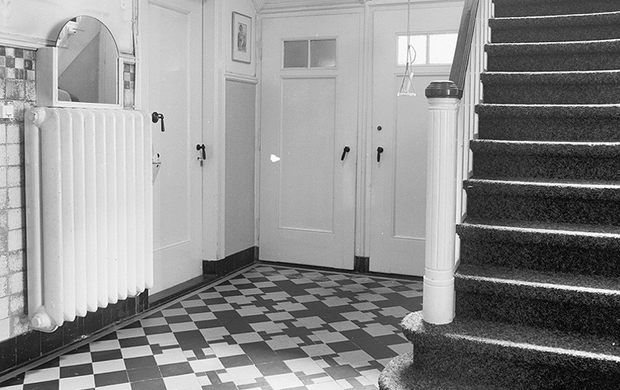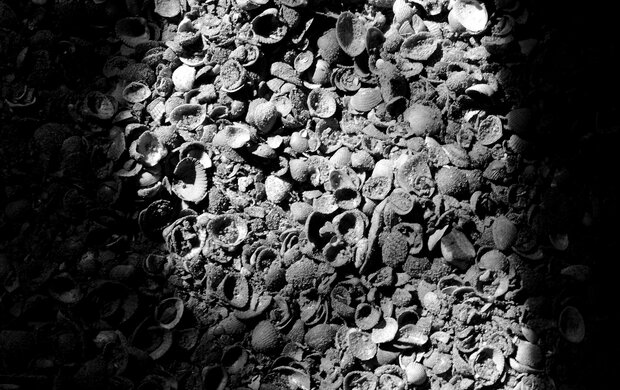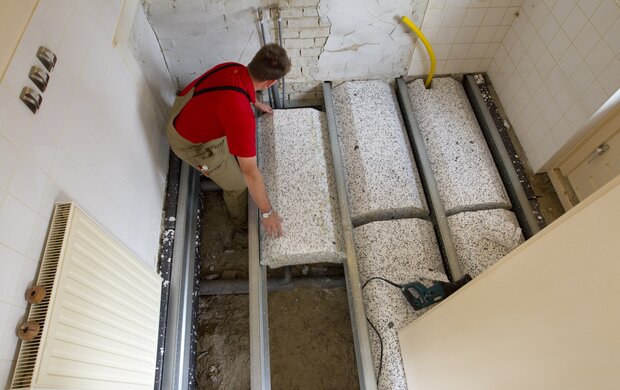Choose your municipality
There are several municipalities connected with The Green Menu, check whether your municipality is participating or choose for the national page.
Choose you menu card
There are several different menu cards. Choose a buildingtype down below and instantly start with the sustainable options!

Floor insulation is a way to save energy. Proportionally, in uninsulated historical buildings, most of the energy is lost through the roofs. But at least 4% of the energy losses occur through the ground floor. There are various possibilities for floor insulation. Insulation on the underside of the floor is often less drastic, but not always possible. Insulation at the top of the floor of historical buildings is not always advisable or permitted, as this could damage the valuable interior. Historical floors can be preserved by laying a ‘loose’ new floor over them, which can later be easily removed.

If your building has a basement or crawl space higher than 35-50 cm, it is possible to insulate the ground floor from below. From the crawl space or basement, the insulation material is applied under the floor, for example between the wooden beams. This saves energy, provides more comfort and can be applied without modifications to the existing floor. If there is water in the crawl space or basement, this needs to be taken care of first. In addition, always ensure that there is sufficient ventilation in the crawl space or basement so that moisture can always be removed. Therefore, always seek proper advice from a professional company.
If your building has a basement or crawl space higher than 35-50 cm, it is possible to insulate the ground floor from below. From the crawl space or basement, the insulation material is applied under the floor, for example between the wooden beams. This saves energy, provides more comfort and can be applied without modifications to the existing floor. If there is water in the crawl space or basement, this needs to be taken care of first. In addition, always ensure that there is sufficient ventilation in the crawl space or basement so that moisture can always be removed. Therefore, always seek proper advice from a professional company.

If the ground floor is not accessible from below, the floor can be insulated from above, which improves the comfort of the building. To apply the floor insulation, the existing floor must be removed. It is therefore advisable to have this done if the floor is to be replaced anyway or if you are switching to underfloor heating. There are systems in which floor insulation and underfloor heating are combined. Keep in mind that the floor will be 6 to 10 cm higher due to the insulation, this has consequences for connections with doors and stairs. Therefore, seek proper advice and prevent historical parts from being damaged. On monumental floors, it must be possible to remove the floor insulation later and return the floor to its original condition.
A floating screed or floating floor is a floor that has not been applied directly to the substrate and can be removed without permanent consequences. This type of floor is therefore very suitable for monumental floors.
If the ground floor is not accessible from below, the floor can be insulated from above, which improves the comfort of the building. To apply the floor insulation, the existing floor must be removed. It is therefore advisable to have this done if the floor is to be replaced anyway or if you are switching to underfloor heating. There are systems in which floor insulation and underfloor heating are combined. Keep in mind that the floor will be 6 to 10 cm higher due to the insulation, this has consequences for connections with doors and stairs. Therefore, seek proper advice and prevent historical parts from being damaged. On monumental floors, it must be possible to remove the floor insulation later and return the floor to its original condition.

Is the crawl space less than 35 cm high and poorly accessible? And further excavation is not permitted or not feasible, floor insulation is often not an option, but soil insulation is. In this case, the insulation material is sprayed into the crawl space, creating an insulating layer at the bottom of the crawl space. Various materials are available, including shells and EPS granules. Seek proper advice regarding which material best suits the conditions of your crawl space. Floor insulation helps against soil moisture, which keeps the crawl space and the living space above it drier. Dry air heats up faster than damp air, which reduces the heat demand. However, the insulating effect of soil insulation is slightly less compared to floor insulation.
Is the crawl space less than 35 cm high and poorly accessible? And further excavation is not permitted or not feasible, floor insulation is often not an option, but soil insulation is. In this case, the insulation material is sprayed into the crawl space, creating an insulating layer at the bottom of the crawl space. Various materials are available, including shells and EPS granules. Seek proper advice regarding which material best suits the conditions of your crawl space. Floor insulation helps against soil moisture, which keeps the crawl space and the living space above it drier. Dry air heats up faster than damp air, which reduces the heat demand. However, the insulating effect of soil insulation is slightly less compared to floor insulation.

If the floor of your property is in very poor condition and is not historically valuable, it may be interesting to investigate whether the ground floor can be replaced by an insulated concrete floor. This will give you a floor with very good insulation value. It is possible to combine the new screed directly with underfloor heating. Comfort will increase considerably and the energy savings are also relatively high.
If the floor of your property is in very poor condition and is not historically valuable, it may be interesting to investigate whether the ground floor can be replaced by an insulated concrete floor. This will give you a floor with very good insulation value. It is possible to combine the new screed directly with underfloor heating. Comfort will increase considerably and the energy savings are also relatively high.
Noise nuisance can be annoying. There are two ways sound moves through a building: airborne noise and impact noise.
Impact sound is sound that vibrates through the structure, for example, by sliding furniture or walking. With a floating screed, for example, impact sound can be significantly reduced because vibrations cannot be transmitted.
Airborne noise comes from both inside and outside and moves through the air. A secondary window or acoustic insulation material, for instance, can reduce airborne noise from the outside by increasing the structural mass and sealing seams and gaps.
First determine what type of noise nuisance is present. Usually, an insulation measure lends itself well to integrating sound insulation into the structure. For example, there are insulation materials that, in addition to thermal properties, also have good acoustic properties. Make sure that the monumental value of the historic building is not affected, such as ornamental ceilings and monumental floors. For instance, make sure that changes are reversible.